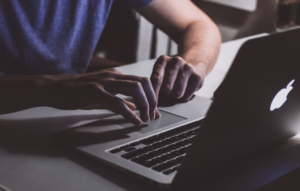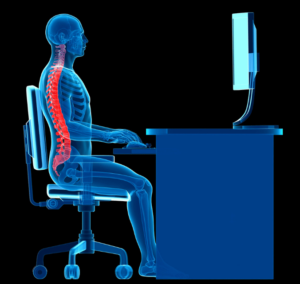The transition to remote work has been a significant shift that an ever-increasing amount of people are taking on, bringing some serious opportunities as well as serious challenges. While working from home can obviously offer flexibility and convenience, it also presents unique obstacles to maintaining our health and well-being. For men, in particular, the home office environment can lead to a sedentary lifestyle, increased stress, and blurred lines between work and personal life.
In this guide to working from home, we’ll explore essential strategies to help you create a productive and healthy remote work routine, many of which have helped to bring you this article today. From setting up an ergonomic workspace to incorporating regular exercise and managing digital wellness, this comprehensive guide is designed to help you thrive in your home office.
By prioritizing your physical and mental health, you can not only maximize your productivity but also enjoy a balanced and fulfilling remote work experience. Let’s dive in and discover how you can make the most of working from home in the digital age.
Setting Up Your Home Office
The foundation of a successful work-from-home experience starts with selecting the right space. Ideally, choose a quiet, dedicated area that is separate from your living spaces. This can help create a mental distinction between work and relaxation, which is crucial for maintaining productivity and focus. A spare room or a corner in a less-trafficked area of your home can work wonders.
Ergonomic Furniture and Equipment
Investing in ergonomic furniture and equipment is 100% worth it. These can help prevent discomfort, long-term health issues, and overall friction with your workspace. Here are the key things to consider:
- Chair and Desk: Choose a chair that supports your lower back and promotes good posture. Your desk should be at a height where your arms rest
 comfortably at a 90-degree angle when typing.
comfortably at a 90-degree angle when typing. - Monitor Height and Distance: Position your monitor at eye level, about 20-30 inches away from your face. This setup helps reduce strain on your neck and eyes, preventing discomfort and fatigue.
Organizing Your Workspace
A well-organized workspace can significantly enhance your productivity, and again, minimize mental/emotional friction (reduction of friction is a key theme here). Keep your desk clutter-free and ensure that everything you need is within arm’s reach. Use organizers, shelves, and drawers to store items neatly. Additionally, personalize your space with items that inspire you, such as plants, photos, or artwork, to create a pleasant and motivating environment.
By thoughtfully designing and setting up your home office, you create an environment that’s conducive to focused and efficient work. This is the foundation for a successful, healthy, and enjoyable remote work experience.
Creating a Healthy Work Routine
One of the main challenges of working from home is the potential for blurred boundaries between work and personal life. Establishing a consistent schedule can help you maintain a sense of normalcy and discipline. Start your day at the same time each morning, and create a routine that mimics your pre-remote work habits, such as getting dressed for the day and having a proper breakfast.
Setting Boundaries Between Work and Personal Time
It’s crucial we have clear boundaries to prevent work from encroaching on our personal lives and vice versa. Define specific work hours for yourself and stick to them as closely as possible. Communicate these boundaries with family members or housemates to minimize interruptions. When your workday ends, make a conscious effort to disconnect from work-related tasks and fully enjoy your personal time.

Plan Regular Breaks to Prevent Burnout
Taking regular breaks is essential for maintaining productivity and preventing burnout. Implement techniques like the Pomodoro method, which involves working for 25 minutes and then taking a 5-minute break. After four cycles, take a longer break of 15-30 minutes. Use these breaks to stretch, hydrate, or step outside for some fresh air. The key is to give your mind and body a chance to recharge.
Staying Organized and Prioritizing Tasks
Keeping a daily planner and/or using digital tools to organize your tasks and set priorities is even more important when working from home. The freedom we gain in working outside of an office requires us to develop our own structures so that we do not fall into chaos. Break your work into manageable chunks and focus on one task at a time. This approach not only fosters greater productivity but also reduces the stress of feeling overwhelmed by a never-ending to-do list.
Mindful design of structure is essential for maximizing productivity and well-being in this digital work-sphere. By setting a consistent schedule, establishing boundaries, and taking regular breaks, you can create a balanced and effective work-from-home lifestyle, but you really do have to work at it.
Maintaining Physical Health
Working from home can and often does lead to a more sedentary lifestyle, making regular exercise even more crucial. Physical activity not only boosts our energy levels but also improves our mood and overall well-being. Aim for at least 30 minutes of moderate exercise most days of the week.
Simple Home Workout Routines
You don’t need a gym membership to hit the bare minimum requirements of fitness. Here are some simple home workout routines to keep you active:
- Bodyweight Exercises: Push-ups, squats, lunges, and planks can be done anywhere and can surprisingly build a lot of strength if done consistently and intentionally.
- Cardio Workouts: Jump rope, jogging in place, or following an online cardio class are all easy and accessible ways to get your heart rate up.
- Yoga and Stretching: These exercises improve flexibility, reduce stress, and help prevent the stiffness that comes from sitting for long periods.
Stretching Exercises to Combat the Sedentary Trend
Sitting for extended periods can lead to muscle stiffness, poor posture, and just outright discomfort. Incorporate some stretching exercises into your daily routine to alleviate these issues:
- Neck and Shoulder Stretches: Gently tilt your head from side to side and roll your shoulders to release tension.
- Back Stretches: Stand up and reach for the ceiling, then bend forward to touch your toes.
- Hip Flexor Stretches: Kneel on one knee and push your hips forward, holding the stretch for 20-30 seconds on each side.
- Hanging – The King of All Stretches: If you have access to a pull-up bar, hang from it for a few minutes each day – if you don’t have one, get one. This simple action is one of the best things you can do to decompress your spinal column and stretch your back, shoulders, hips, and arms. This is an absolute game-changer.
Dietary Considerations
Nutrition plays a vital role in maintaining your energy levels and overall health – obviously – but less obvious are the pitfalls that many people fall into when they start working from home. Access to your kitchen at any point and a lack of peers to look at you strangely for stuffing your face with Doritos all day or just not eating all day can be a dangerous mix. Here are some tips for healthy eating while working from home:
- Plan Your Meals: Routine is another key theme here. Prepare your meals or at least your plans in advance to avoid unhealthy snacking. Include a balance of proteins, healthy fats, and complex carbohydrates.
- Stay Hydrated: Drink plenty of water throughout the day to stay hydrated and focused.
- Limit Caffeine and Sugar: While it’s tempting to reach for another cup of coffee or a sugary snack, too much caffeine and sugar can lead to energy crashes, issues with sleep, heightened propensity for panic attacks, and
 metabolic issues.
metabolic issues.
By incorporating regular exercise, stretching, and healthy eating habits into your daily routine, you can mitigate the physical challenges of working from home and protect or even uplift your overall health and well-being.
Considerations for Mental Health
Managing Stress and Anxiety
Working from home can blur the lines between professional and personal life, leading to the buildup of stress and anxiety. One has to take great care to manage these variables to maintain mental well-being:
- Set Realistic Goals: Break down tasks into manageable chunks and set achievable goals. This can reduce feelings of overwhelm and help you stay focused.
- Practice Deep Breathing: Incorporate deep breathing exercises into your routine to calm your mind and reduce stress. Simple techniques like inhaling deeply, holding the breath for a few seconds, and exhaling slowly can be very effective.
- Stay Organized: Use planners or digital tools to keep track of your tasks and deadlines. A clear plan can help you feel more in control and less stressed.
Mindfulness and Meditation Practices
Mindfulness and meditation are not just woo woo activities for chicks to do at yoga retreats in Costa Rica, as they are often dismissed as – they are seriously powerful tools for enhancing mental clarity and reducing stress. Even a few minutes each day can make a significant difference:
- Mindfulness Meditation: Spend a few minutes each day focusing on your breath and observing your thoughts without judgment. This practice can help you stay present and reduce anxiety.
- Guided Meditation Apps: Use apps like Headspace or Calm to access guided meditations that can help you relax and unwind.
Tips for Staying Socially Connected
Social isolation is a big one when working from home. A lot of our friendships and general human interactions happen through us going to work at a physical location. Though it’s often shrugged off, social connection is a crucial part of our mental health, so we have to solve for that when working from home:

- Regular Check-Ins: Schedule regular video calls or phone calls with colleagues and make time for in-person time with friends and family to maintain social connections.
- Virtual Social Activities: Participate in virtual social activities like online game nights, group workouts, or virtual coffee breaks.
- Join Online Communities: Engage with online communities or forums related to your interests to connect with like-minded individuals.
By actively managing stress, incorporating mindfulness practices, and cultivating

social connections, you can maintain your mental well-being while working from home. Prioritizing mental health is essential for a balanced and productive remote work experience.
Digital Wellness
Working in the digital age poses some unique challenges, especially when it comes to maintaining our health and well-being in an environment not designed with the nuances of our biology in mind.
Risks of Prolonged Screen Time and Blue Light Exposure
Spending long hours in front of a computer or phone can have detrimental effects on your health. Prolonged screen time can lead to eye strain, headaches, and disrupted sleep patterns due to blue light exposure. Understanding these risks is the first step toward mitigating them.

To cultivate what we call your “digital wellness”, it’s important to manage and monitor your screen time:
- Set Daily Limits: Use apps like Screen Time (iOS) or Digital Wellbeing (Android) to set daily limits for app usage. This helps ensure you’re not spending excessive time on non-work-related activities.
- Scheduled Breaks: Incorporate regular breaks using techniques like the Pomodoro method, where you work for 25 minutes and then take a 5-minute break away from screens.
- Night Mode and Blue Light Filters: Enable night mode or blue light filters on your devices in the evening to reduce blue light exposure, which can interfere with your sleep.
Importance of Digital Detoxes
As we spend increasing amounts of time looking at screens and working on computers, breaks from digital devices become increasingly crucial to rejuvenate our mind and body:
- Digital Detox Days: Designate certain days or weekends where you limit or completely avoid screen time. Use this time to engage in offline activities like reading, hiking, or spending time with family.
- Device-Free Zones: Create device-free zones in your home, such as the dining room or bedroom, to promote more mindful and present living.
Using Technology to Your Advantage
While it’s important to manage screen time, certain technologies can also enhance your digital wellness.

Products like those from Aires Tech can help reduce exposure to electromagnetic fields (EMFs) emitted by digital devices. These tools are designed to create a safer digital environment, helping to minimize the potential health risks associated with prolonged screen time.
Prioritizing digital wellness is key to preventing burnout and ensuring long-term health while working from home.
Conclusion
Maintaining health and wellness while working from home is crucial for both productivity and overall well-being. By setting up an ergonomic workspace, creating a consistent and healthy work routine, staying physically active, and managing stress, you can effectively navigate the challenges of remote work.
Remember to set boundaries between your professional and personal life, incorporate regular exercise and stretching into your daily routine, and practice mindfulness to manage stress. Additionally, be mindful of your digital wellness by setting screen time limits and taking regular digital detoxes; consider using an Aires Tech device to minimize some of that inevitable EMF exposure as well.
By following the strategies outlined in this guide, you can create a balanced and healthy work-from-home experience. Embrace the flexibility of remote work while prioritizing your health, and you’ll find yourself thriving both professionally and personally.


 comfortably at a 90-degree angle when typing.
comfortably at a 90-degree angle when typing.






